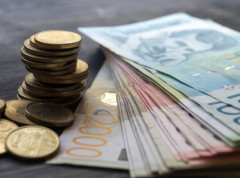Representatives of the financial sector predict that inflation in Serbia is likely to be restrained in the near future, but it is not realistic to expect a decrease in any consumer prices, including the prices of financial products, such as loans, leasing, and insurance, writes „Biznis i finansije“ (B&F).
Inflation in Serbia has reached 4.5%, which is the upper limit of the target set by the National Bank of Serbia, so the Serbian central bank has started reducing the key interest rate, just like the European Central Bank. However, the reduction of NBS rates for loans in dinars and ECB rates for loans indexed in euros will not quickly or significantly affect the reduction of interest rates in commercial banking, and, as bankers suggest, more noticeable reductions can be expected only at the beginning of 2025.
„Raiffeisen Bank“ barely leads in profitability
It is quite expected that banks will not lower interest rates as their clients would like, because they don’t have to. Competition in the Serbian financial market is such that banks practically have a monopoly and the possibility of borrowing, and thus the loan price, is limited.
And the earnings relationships have been shown in the latest annual edition of „Finance TOP 2023/24“ by „B&F“. According to this list, „Raiffeisen Bank“ is the most profitable bank in Serbia in 2023, with a profit of 21.4 billion dinars. In terms of insurance, „Dunav Osiguranje“ is in the first place, with a premium exceeding 40 billion dinars last year.
The success of „Raiffeisen Bank“, whose profit is slightly higher than „Banka Inteza“, is partly due to one-time effects after the bank took over „Credit Agricole,“ says „Finance TOP 2023/24“.
„Inteza“ is in second place with a profit of 21 billion dinars, followed by „Unicredit“ with a profit of 18.5 billion dinars, „OTP“ recorded a profit of 16.7 billion dinars and took the fourth position, while the fifth is „NLB Komercijalna Banka“ which achieved a final result of 15.1 billion dinars.
On the list of assets, „Inteza“ leads with a share of 15.6%, followed by „OTP“ (13.9%), „AIK“ (13.1%), „Raiffeisen“ (11.2%), and „Unicredit“ (10.7%).
Golden age for bankers
According to the annual edition, the net profit of banks in 2023 reached 122.2 billion dinars, after most industry players achieved record results in their history. The average return on equity in the banking sector was around 15%. The main reason for last year’s profit increase was, of course, net interest income, which increased by 52% to 227.6 billion dinars.
In addition to the rapid rise in loan interest rates and modest prices paid for client deposits, a significant contribution to the end result of 77.3 billion dinars came from net incomes based on famous fees and commissions, which increased by 11% compared to 2022.
Banks made a profit of 43.3 billion dinars in the first quarter of 2024, which is an increase of 29% compared to the previous year, but it is difficult to expect that this pace of growth will continue until the end of the year, as assessed in the edition „Finance TOP“.
Net interest income, due to more expensive sources of financing (increase in deposit interest rates), increased by „only“ 28%, to 62.4 billion dinars, while net income from fees and commissions accelerated by 17%, to 20 billion dinars.
Banks from the EU more profitable in Serbia than at home
Banks from Western Europe operating in Central and Eastern Europe (CEE), including Serbia, achieve a higher return on equity compared to the Western European market, thus increasing profitability for both themselves and their parent banks.
Despite slower credit activity, the profitability of subsidiaries of Western European banks in CEE reached a record level in 2023, with the greatest potential for further growth of the banking sector in Romania, Serbia, Bosnia and Herzegovina, and Albania.
At the same time, further consolidation of the banking market in the region is expected, which is most pronounced in Hungary, Romania, and Serbia, as stated in the Finance TOP edition.
Voluntary health insurance leading in insurance market
In the insurance market, last year, „Dunav Osiguranje“ was first with a premium slightly exceeding 40 billion dinars, or market share of 26%.
Second is „Generali Osiguranje“ with a premium of nearly 29 billion dinars and a market share of 18.7%, while third is „Wiener Staedtische“ with a premium of 17.4 billion dinars and a market share of 11.3%.
Following is „DDOR Novi Sad“ which collected 16.9 billion dinars in premium and has a market share of 10.9%, while in fifth place is „Triglav Osiguranje“ with 11.3 billion dinars in premium and a market share of 7.3%, as shown in the ranking list of the economic monthly magazine „Biznis i Finansije“.
Insurance companies in Serbia achieved a total premium of 155.25 billion dinars in 2023, 22 billion (16.5%) more than in 2022.
This result was most influenced by the increase in the price of compulsory motor third-party liability insurance, where the premium for a year rose from 38.9 billion dinars to 46.2 billion dinars, and then voluntary health insurance, which generated a premium of 14.58 billion dinars, 4.68 billion more than in 2022. Voluntary health insurance is also the fastest-growing insurance with a 47% increase.
In the past year, over 700 million euros in damages were settled, with the majority, over 520 million, related to non-life insurance. In addition to the premium growth, voluntary health insurance was also leading in terms of claim growth, reaching up to 57%, as stated in the Finance TOP edition.
Leasing grew, inflation slowed down fund recovery
The value of newly concluded financial leasing contracts in Serbia in 2023 was 773 million euros, representing an annual growth of 10.6%. This positive trend was continued in the first three months of the current year, with the value of newly concluded contracts being 20% higher than in the same period last year.
Passenger vehicles were the most represented, with a 47% share of total financing in the first quarter. The most numerous users of financial leasing in 2023 were companies in the transport and information sector, which invested 205.5 million euros in the Serbian economy in this way.
The net assets of pension funds amounted to 53.8 billion dinars at the end of the fourth quarter of 2023, a nominal annual increase of 11.5%, but high inflation reduced the growth to a real 3.9%.
In the assets of voluntary pension funds, state securities had the largest share of 70.1%, fixed and funds on bank custody accounts accounted for 17.8%, investments in stocks of companies listed on the stock exchange were 10.8%, and 0.9% was invested in units of open-end investment funds. Claims accounted for 0.4% of the total assets of voluntary pension funds.
The net assets of investment funds in 2023 amounted to approximately 104 billion dinars, an increase of 66% compared to 2022, while the number of new members increased by about 40%.
All funds achieved returns in the range of 2.49% to 21.16% in 2023. However, due to high annual inflation at 12.1%, only four funds managed to preserve the capital of their investors, as they had a return greater than inflation.






